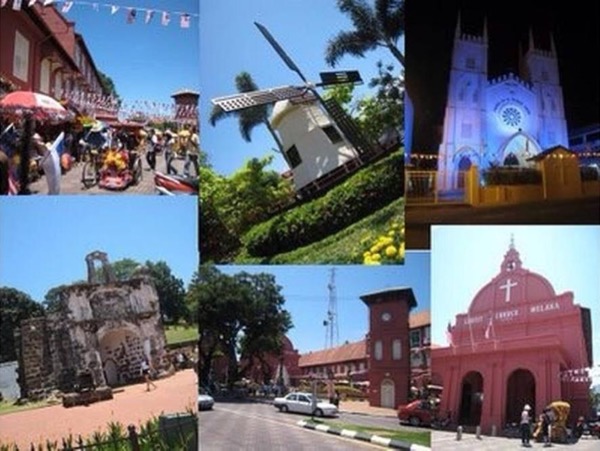
Chinese designs incorporated in mosques
MyKampung 2012-02-28 18:50
Members of Friends of Melaka Museums posing for group photo at the end of their visit. Front row second from left is Haji Shaukani Abbas, with Iesnordin on the extreme right. Photo courtesy by Sin Chew Daily
3 of 7
Translated by WINNIE CHOOI
Sin Chew Daily
MELAKA -- The structure of Kampung Kling Mosque in Melaka built in the 18th century boasts of various characteristics of the Chinese, Hindu, Sumatran and Malay cultures.
The Chinese character of double happiness carvings and a rostrum are obvious evidences of close connection with the Chinese architecture during the olden days," explained the person-in-charge at the southern region Department of Museums Iesnordin Hj. Malan, during the Melaka Cultural Heritage Tour in July organised by Friends of Melaka Museum.
Also responsible for the mosque's reconstruction in 1999, Iesnordin attended the activities held on 13 July 1999 that saw the participation of people from various ethnic groups such as Chinese, Muslims, Hindus, Nyonyas, Chettis, and French residing in Malaysia.
After refurbishment
"Tiles carvings on the roof of the mosque is identical to the ones in Cheng Hoon Temple but were concealed with white spray after the refurbishment," said Iesnordin.
The mosque was built on a square site supported by four symmetrical arches made of "kayu berlian" in the prayer hall. Coral made flower-shaped bunga kesidang ornaments adorned the roof while Dutch tiles were used as roof tiles.
Kampung Kling Mosque was originally built in wood in 1748 and later reconstructed in bricks in 1872. It was subsequently refurbished in 1908 using Dutch roof tiles with a pagoda-like minaret like in Kampung Hulu Mosque. The latest conservation works were carried out in 1999.
"Most people were curious why there were two mosques built within the same area. From what I understand they could belong to different ethnics communities. The Kampung Kling Mosque was named this way because it was erected by Indian Muslims.
"Secondly, Kampung Hulu Mosque was supposed to be demolished by the colonial government and be replaced with a new one but the plan was later cancelled," said Iesnordin.
Muslim living
A key speaker in Islamic living, retired teacher Hajjah Nasri Abbas said she remained adhered to the Islamic faith even after she came into contact with people of different religions during her studies in the United States.
"Among the five rules set by the mosque, one is to attend the Hajj pilgrimage at least once in a lifetime. The children or relatives could be the representatives if a Muslim is incapable of carrying out the duty," said Abbas.
In order to form a good rapport between Muslims and non-Muslims, some non-Muslims would tend to greet Muslims by saying "Assalamuailam." However, Abbas said this is not appropriate as it means "may peace be with you" in Quran.
Abbas added that Muslims pray five times a day just like talking to Allah over the phone. The length of prayers for each session is different. Shorter prayers are practised in the pre-dawn at 5.51a.m. as well as in the evening at 4.30p.m.
Abbas pointed out further that Muslims are encouraged to pray more than five times a day. The prayers could be carried out at home or in praying rooms (surau). However, Muslim men must visit the mosque every Friday to pray with the public. No short pants or undergarments are allowed inside the mosque.
"As for Muslim women, prayers are normally carried out in their private rooms at home. Women should not be seen too often inside the mosque to avoid unnecessary distractions to the men. Due to this reason, females should put on their exclusive prayers costume concealing their whole bodies except face and hands.
"In Afghanistan, females have to cover their face and eyes as well and are not allowed to pray during their menstrual periods, " said Abbas.
New members welcome
Newly appointed Chairman of Friends of Melaka Museums, Haji Shaukani Abbas said the association is a non-government organisation set up long ago. The monthly Melaka Cultural Heritage Tour has so far been organised three times after he took over as chairman.
The organisation offers a lot of perks such as free entrance to museums, discounted prices for museum-related products and access to museum library for reading and research purposes.
The objective is to provide local people with an opportunity and platform to participate, promote and protect our cultural heritage, and strengthen the relationship between the communities with the museums through leisure activities.
Members of the public are welcome to join as members. Membership fees and contact details are as follows:
Individual membership: RM10 per annum
Children: RM2 per annum
Foreign membership: RM10 per annum
Lifetime membership: RM100
Enrolment fees: RM5
Please call 012-612 0618 or 06-282 6526/06-281 1289 for details.

No comments:
Post a Comment